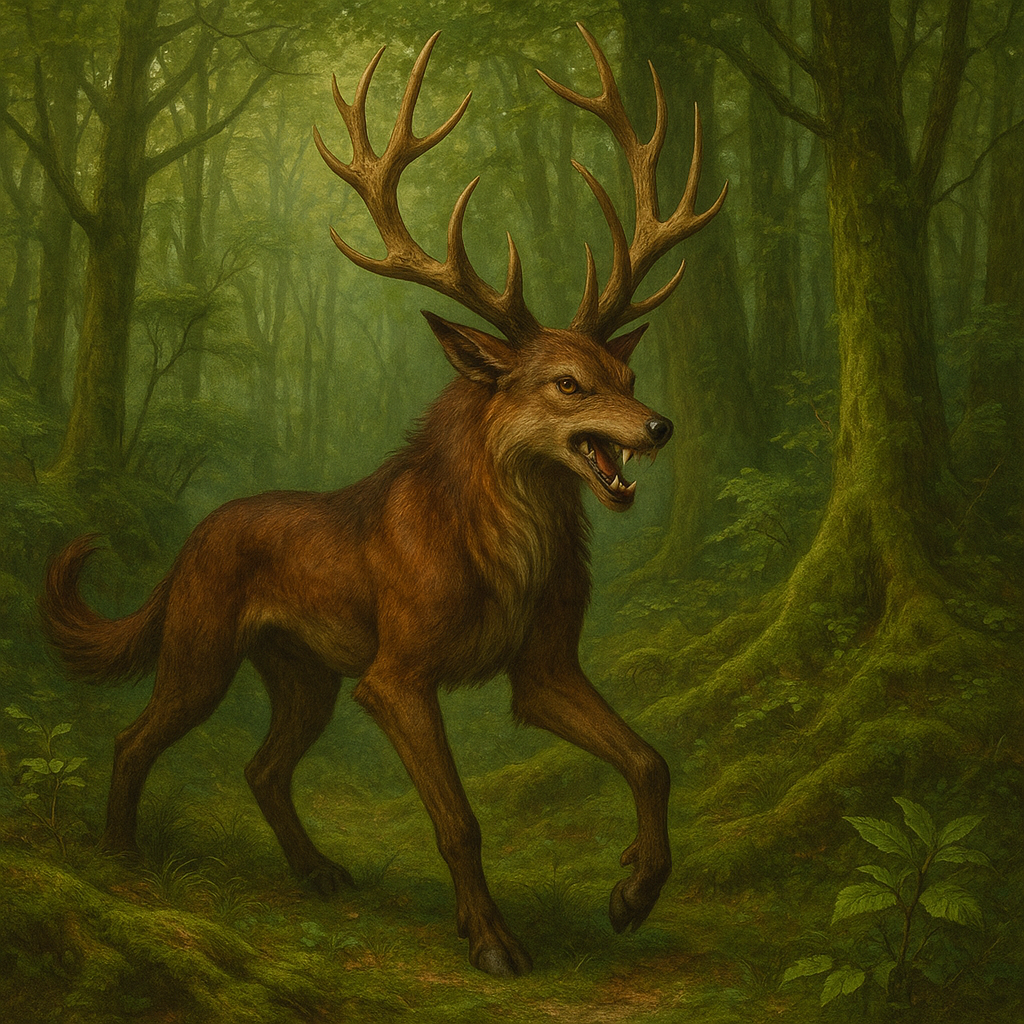Dancers
"It bowed before it killed. That was the worst part. The grace of it. Like it knew it was art." -From a field report recovered outside Woodswatch Pass.
In the dappled silence of forested Everwealth, few creatures stir fear and awe as evenly as the Dancer. A hybrid of elegance and lethality, the Dancer is a sinuous blend of wild hound and towering stag, a beast shaped for both pageant and pursuit. Born of old magick, natural cunning, and ecological necessity, it strikes like a memory made flesh: with beauty, and with blood. Though often mistaken for a deformed wolf or malformed elk at a distance, a closer view reveals its true terror, the Dancer is neither and both. When it moves, it does so with fluidity unnatural for something of its size, swaying side to side like a ritual blade before the plunge. Its long body and powerful gait are punctuated by moments of sudden violence: a slash of claw, a snap of antler, the low rumble of a throat preparing to strike. One moment, it is still as stone; the next, a blur of muscle and instinct, striking from the underbrush like an assassin in a ballad.Basic Information
Anatomy
The Dancer is a creature of striking anatomical synthesis, its form blending the elegance of the stag with the precision of the wolf. Its head is distinctly lupine, narrow and powerful, with long, alert ears that twitch at even the faintest rustle in the underbrush. The creature’s body is clad in a thick pelt that shifts in tone from deep rust-red to soil-brown, occasionally flecked with pale markings along the spine or throat. Its forelimbs are padded and pawed, allowing it to tread silently and with remarkable dexterity through wooded terrain, while its hind legs end in hard, cervine hooves, spring-loaded with lean muscle ideal for explosive lunges, vertical ascents, and devastating charge-kicks. Crowning its head are sweeping antlers, wide and sharpened, used in both ritualistic display and brutal melee. When bloodied in battle, they stain easily, framing the Dancer in a grotesque, haloed silhouette that haunts the memories of any who survive the encounter. Its tail, long and elk-like, is subtly flexible and often expressive, wagging in moments of curiosity or curling mid-run to aid in sharp turns. It serves as both rudder and social signal, revealing mood, momentum, and pack alignment with every flick.
Genetics and Reproduction
Dancers are viviparous, giving live birth to litters of 1-2 calves after a gestation of roughly six months. Breeding pairs are bonded seasonally, but long-term loyalty has been observed among more intelligent packs. Calves are born with blunt antler nubs and padded hooves to avoid injuring the mother.
Growth Rate & Stages
- Calf (0-3 months): Weak but mobile; weaned on regurgitated fruit and meat.
- Yearling (3 months-1 year): Begins hunting with the pack; training phase.
- Young Adult (1-3 years): Grows antlers and muscle; tested in full hunts.
- Mature (3+ years): Capable of leadership and reproduction.
Ecology and Habitats
Found in temperate forests and mild alpine regions, the Dancer thrives in:
- The Grandgleam Forest, especially near The Woodswatch Mountains. They nest in large den-clefts dug between roots and cliff bases, returning seasonally.
Dietary Needs and Habits
Dancers are omnivores, feeding on:
- Small to midsize prey (rabbits, deer, wild boar).
- Berries, mushrooms, saplings.
- Carrion when fresh.
Biological Cycle
Dancers shed their antlers annually in mid-winter and regrow them by early spring. During this time, they become more reclusive and irritable. Mating season occurs in late spring, when the forest thickens and prey is most abundant.
Behaviour
Highly social, Dancers operate in structured packs with informal but evident hierarchies. They are coordinated, intelligent, and deeply expressive. Packs may mourn lost members, exhibit group teaching behavior for young, and will retaliate violently if one of their own is slain.
Additional Information
Perception and Sensory Capabilities
Dancers possess:
- Acute hearing attuned to wind distortion.
- Strong olfactory range; can track blood or pack-mates over miles.
- Excellent night vision.
Scientific Name
Cervicanis bellator.
Origin/Ancestry
Dancers are believed to be the offspring of ancient crossbreeding between canine predators and deepwood cervids.
Conservation Status
Not endangered, but subject to poaching and black-market domestication. Territories have shrunk due to deforestation. Protected by nature-worshipping cults and some elken clans.



Comments